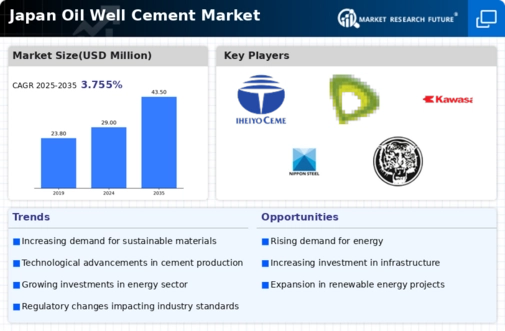Growing Focus on Safety Standards
Safety remains a paramount concern in the oil and gas sector, significantly impacting the oil well-cement market. Japan's regulatory bodies have established rigorous safety standards for drilling operations, which necessitate the use of high-quality cement to ensure well integrity. In 2025, it is projected that compliance with these safety standards will drive a 25% increase in demand for premium oil well-cement products. The oil well-cement market must prioritize safety in product development, ensuring that offerings not only meet regulatory requirements but also enhance operational safety for drilling companies.
Rising Demand for Energy Resources
The oil well-cement market in Japan experiences a notable increase in demand due to the country's ongoing pursuit of energy resources. As Japan seeks to enhance its energy security, the exploration and production of oil and gas become paramount. This trend is reflected in the growing number of drilling activities, which necessitate the use of high-quality cement for well construction and maintenance. In 2025, the Japanese government aims to boost domestic oil production by 15%, thereby driving the need for reliable oil well-cement solutions. The oil well-cement market must adapt to these evolving demands, ensuring that products meet the rigorous standards required for successful drilling operations.
Environmental Regulations and Compliance
The oil well-cement market in Japan is increasingly influenced by stringent environmental regulations. The government has implemented policies aimed at reducing the environmental impact of oil and gas operations, which directly affects cement usage. Compliance with these regulations often necessitates the adoption of eco-friendly cement alternatives, which may lead to a shift in market dynamics. In 2025, it is expected that 40% of cement used in oil well applications will be derived from sustainable sources. The oil well-cement market must navigate these regulatory landscapes, ensuring that products not only meet performance standards but also align with environmental goals.
Investment in Infrastructure Development
Japan's commitment to infrastructure development significantly influences the oil well-cement market. The government has allocated substantial funds for enhancing energy infrastructure, including oil and gas facilities. In 2025, the budget for energy infrastructure is projected to reach ¥1 trillion, reflecting a 20% increase from previous years. This investment is likely to stimulate demand for oil well-cement, as new drilling projects and facility upgrades require robust cement solutions. The oil well-cement market must align its offerings with the evolving infrastructure landscape, ensuring that products are tailored to meet the specific needs of these projects.
Technological Innovations in Cement Production
The oil well-cement market in Japan is poised for transformation through technological innovations in cement production. Advances in materials science and engineering are leading to the development of specialized cement formulations that enhance performance in extreme conditions. For instance, the introduction of lightweight and high-strength cement is expected to improve well integrity and reduce costs. In 2025, it is anticipated that 30% of new cement products will incorporate these innovations, thereby reshaping the oil well-cement market. Companies must invest in research and development to stay competitive and meet the evolving demands of the energy sector.
















Leave a Comment